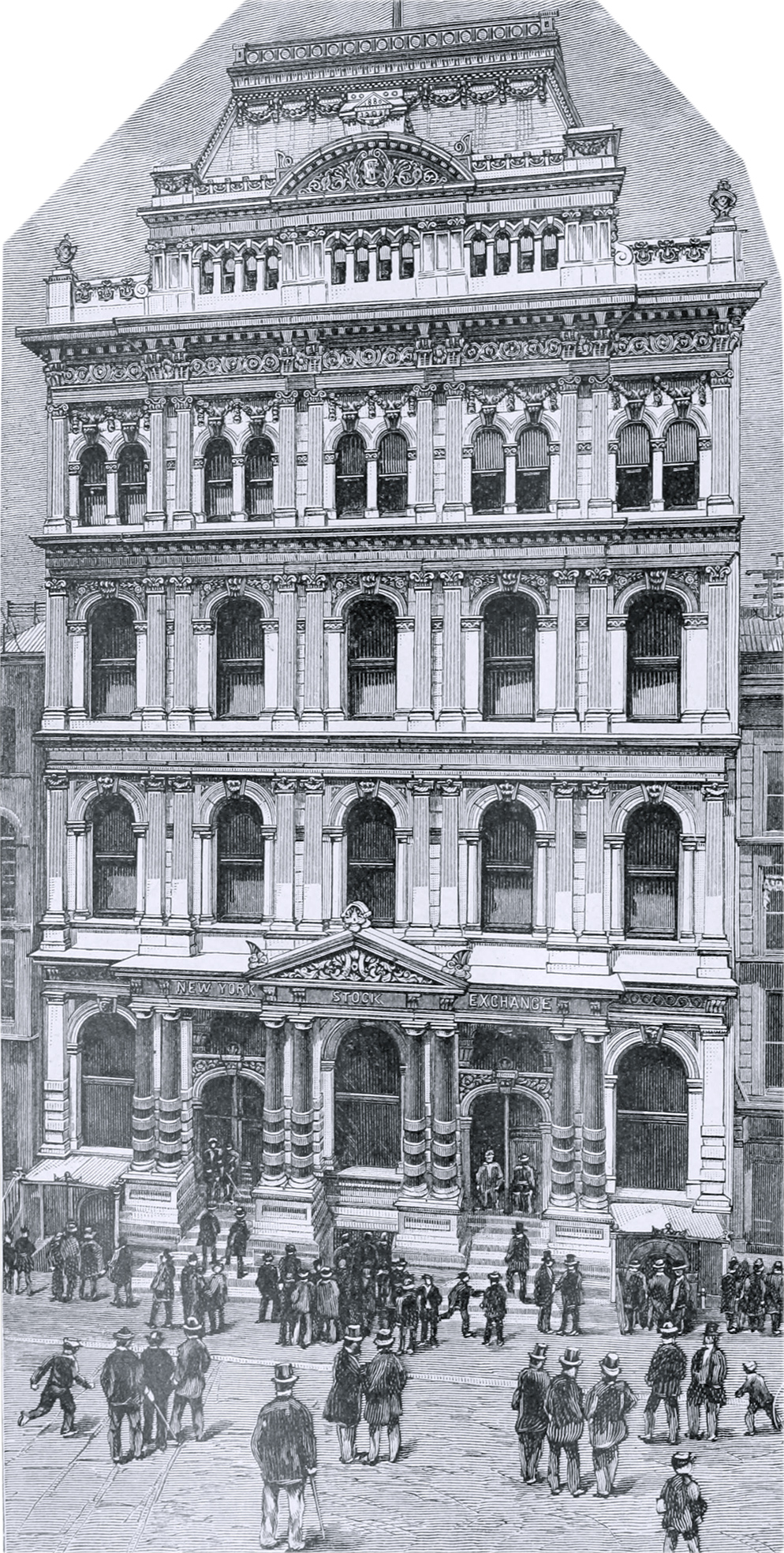
The old New York Stock Exchange building. The NYSE moved to this old building in 1865 and traders worked in it until April 1901, then it was demolished to make way for the present building, completed in 1903. Illustration published in the Harper's New Monthly Magazine, November 1885. Below, some text that accompanied this illustration:
«The New York Stock Exchange is a building, an association, an exchange of securities for currency or its representatives. Ordinarily speaking, it signifies the body of men by whom the change of securities for valuable considerations is effected in an edifice devoted to that purpose. This edifice occupies a portion of the space between Broad and New streets, has a frontage of 65 feet on the first and of 158 on the second thoroughfare, and has also an entrance on Wall Street. It is a solid and unpretentious but imposing structure, designed by James Renwick, the architect of Grace Church and the Roman Catholic Cathedral. Improved arrangements that will give an additional six-sevenths to the floor of the Exchange—now 53 by 140 in size—have been projected by the Governing Committee, and will doubtless be effected. The legal title to all the real estate owned and occupied by the association known as the New York Stock Exchange is vested in the New York Stock Exchange Building Company, of which Donald Mackay is president. The cost of the whole is over $1,800,000, and the amount annually expended by the Committee of Arrangements for its preservation and for the salaries of the different individuals employed therein ranges from $150,000 to $200,000.
Strangers are not admitted to the ground floor except by courtesy. Entering from Wall Street, the Board Room, with its Babel of voices, is on the right, or New Street side. On the left, or Broad Street side, is the Long Room, devoted to telegraphic apparatus and subscribers who pay $100 per annum for the privilege of using it. A door through the partition affords direct ingress to the parlor sacred to brokers, who therein indulge in some reading, more smoking, and incessant draught and chess playing. Stock brokerage and the latter abound in shrewd combinations. Between the Board and Long rooms are telephonic and telegraphic instruments of communication with near and distant offices. The famous Callahan "ticker," whose patent was purchased of the Gold and Stock Telegraph Company by the Western Union Telegraph Company, and which prints its electric messages on endless strips of paper, is perpetually at work during the hours of business. Its owners yearly pay $18,000 to the Stock Exchange for the privilege of giving information about transactions in the market. The Commercial Telegram Company also enjoy the same privileges on the same terms.
Inspection of the Board Room, littered with torn memoranda of executed orders, after the day’s proceedings are over, discovers that the several stocks have their respective locations upon the floor. Here is St. Paul; a board informs us what the price of the last sale was and how many shares were sold on the day previous. Next comes Northwest. At the south end is Reading, also the New York Central. A row of signs pillars runs along the middle of the room from end to end. On the first we find, to the south, Lake Shore, Wabash Preferred, and Common. This stock is not in active demand; the figures show what was bid and what was asked, without any sales. On the second pillar is New Jersey Central and Denver and Rio Grande. In like manner prices and sales of the previous day are recorded of the Oregon Transcontinental and Texas Pacific on the third pillar, of the Missouri, Kansas, and Texas and Louisville and Nashville on the fourth, of the Central Pacific and Manhattan Consolidated (Elevated) Railway on the fifth. Omaha Preferred, Western Union Telegraph, and Union Pacific also have their places on the right of the chairman's rostrum. Mining stocks are sold at the north end of the room. On the New Street side are the Canadian Pacific, Minnesota and St. Louis, Alton and Terre Haute, Rome and Watertown, Erie Second Consols, Mobile and Ohio, Chesapeake and Ohio...»
Old NYSE Building - 1885

Old NYSE Building - 1885
|
Copyright © Geographic Guide - NYC, Images and History. |
